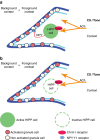HIPP neurons in the dentate gyrus mediate the cholinergic modulation of background context memory salience
- PMID: 28775269
- PMCID: PMC5543060
- DOI: 10.1038/s41467-017-00205-3
HIPP neurons in the dentate gyrus mediate the cholinergic modulation of background context memory salience
Abstract
Cholinergic neuromodulation in the hippocampus controls the salience of background context memory acquired in the presence of elemental stimuli predicting an aversive reinforcement. With pharmacogenetic inhibition we here demonstrate that hilar perforant path-associated (HIPP) cells of the dentate gyrus mediate the devaluation of background context memory during Pavlovian fear conditioning. The salience adjustment is sensitive to reduction of hilar neuropeptide Y (NPY) expression via dominant negative CREB expression in HIPP cells and to acute blockage of NPY-Y1 receptors in the dentate gyrus during conditioning. We show that NPY transmission and HIPP cell activity contribute to inhibitory effects of acetylcholine in the dentate gyrus and that M1 muscarinic receptors mediate the cholinergic activation of HIPP cells as well as their control of background context salience. Our data provide evidence for a peptidergic local circuit in the dentate gyrus that mediates the cholinergic encoding of background context salience during fear memory acquisition.Intra-hippocampal circuits are essential for associating a background context with behaviorally salient stimuli and involve cholinergic modulation at SST+ interneurons. Here the authors show that the salience of the background context memory is modulated through muscarinic activation of NPY+ hilar perforant path associated interneurons and NPY signaling in the dentate gyrus.
Conflict of interest statement
The authors declare no competing financial interests.
Figures







References
-
- Rescorla, R. A. & Wagner, A. R. in Classical Conditioning II (eds Black A. H. & Prokasy W. F.) 64–99 (Appleton-Century-Crofts, 1972).
Publication types
MeSH terms
Substances
LinkOut - more resources
Full Text Sources
Other Literature Sources
Medical
Molecular Biology Databases
Research Materials
Miscellaneous

